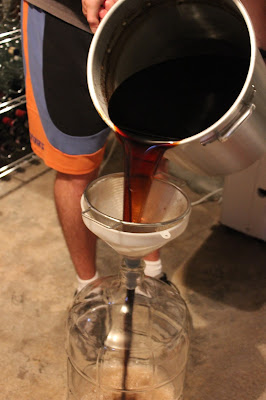Welcome to another awesome Brew Day adventure. A friend of mine commissioned us to make him a vanilla stout. Of course, we could not refuse. We developed a recipe based on a few criteria: vanilla, stout... voila. Well, he wanted the stout to be sweet and have the aroma/flavour of vanilla. So we did have a couple of factors to figure out i.e. how thick to make the mash, and mash temperature. Let us not forget the ingredients, hopping schedule, vanilla additions, primary, secondary, bottling, and most importantly the tasting. It is a little bit past one month since the day this brew was conceived, we definitely do not expect it to last much longer... it is a wonderful beer! The beer was named after my friend, who became my brewing partner for this collaborative brew.
Let the brewing begin!!
In our excited state we forgot to take pictures of the grain ingredients, but we do have the list on hand, so here they are: Black Patent 250g, Chocolate Malt 250g, Roasted Barley 250g, Maris Otter 5kg, Hallertauer Hops 50g, Burton Ale Yeast WLP023, and Tahitian Vanilla Beans!! The recipe here already indicates that the beer should come out tasting like chocolate and espresso with very little bitterness and good, malty sweetness. In fact, the darker the beer the more hops required to taste the bitterness. The total grain bill indicates that the beer - given that we usually hover around 65% conversion efficiency- will be about 4-5% abv (alcohol by volume), and aided by the yeast which is said to attenuate (turn sugar into alcohol) at around 69-75%. However, since we wanted the beer to turn out sweet we had to mash high, which would lower the total amount of fermentable sugars for the yeast to consume. This is the beauty of crafting/creating ones own products, though it would be an exaggeration to say that we have complete control over the end product.
We mashed at 157f (69.5C) for around 60min - insert lunch break... A total of 14 litres of water at 173f (78C) were added to attain our target temperature of 157f (69.5C) with a mash thickness of around 1quarts/lbs. Aiming for a relatively low mash thickness would help boost the total alcohol content by increasing the density of sugar in the wort, while having a high mash temperature reduces the overall fermentability; thus, we are left with a wort that should have a higher abv than the mash temperature would normally allow for... or so we think. The science of mashing is rather complex, and we have yet to get a full grasp on it. But we will!
Once the 60mins were up we mashed-out with 4.8 litres at boiling to raise the total mash temperature to 168f (75.5C) to stop enzyme conversion. That process usually takes between 10 and 15 minutes. After which we collected the first runnings and vorlaufed (recirculate the wort). The pre-boil gravity was measured at 1.032. Immediately following our measuring of the wort's sugar density we placed the brew kettle on the propane burner.
The wort was boiled for 60min during this time we added hops regularly to infuse the wort with hop bitterness, flavour, and aroma (kind of). It usually takes about 15-20min before the wort hits a nice rolling boil. Before it even begins to boil we add or first addition of hops, bittering addition, this helps to reduce the chance of boil-overs - boiling indoors, we hate those more than anything. So, hops were added to bitter before boil (15g), to bitter again with 45min remaining to the boil (15g), for flavour with 25min remaining (15g), and a little bit for aroma with 5min remaining (5g). The aroma addition actually imparted very little to no aroma; 5g is not enough to really influence the character of a beer. The final addition to the wort were the vanilla beans, we added 3 vanilla pods with their beans for aroma and flavour.
The final two steps were the cooling of the wort, which went much faster than usual, this time only 40min. Once cooled to around 75f (24C) we measured the starting gravity (1.050) then pitched our yeast and let the beer ferment for 10 days. We stored the beer in the cold storage room and noticed that the temperature gradually dropped from 75f (24C) to 68f (20C) within a week, but remained steady at 68f (20C).
After those ten
days were up we took another gravity reading, which measured 1.020, and
then we decided to transfer the beer into a secondary carboy with two
more vanilla pods/beans - hoping to impart more vanilla characteristics
to the beer. We left it in secondary for approximately another 10 days
and then we bottled it. The gravity reading remained the same as before,
which means that their were either too many unfermentables for the
yeast to process or that the yeast simply gave up. In the sugar
solution, that is used to prime the beer, we added another two vanilla
pods/beans.
Overall this beer turned out fantastic, that being said, we do not really get too much of the vanilla flavours or aromas which we tried so hard to impart, maybe someone out there has a suggestion for next time?
Thanks for reading, and to all you homebrewers out there give this one a shot and tell us what you think.
Cheers!
- Jean




































No comments :
Post a Comment